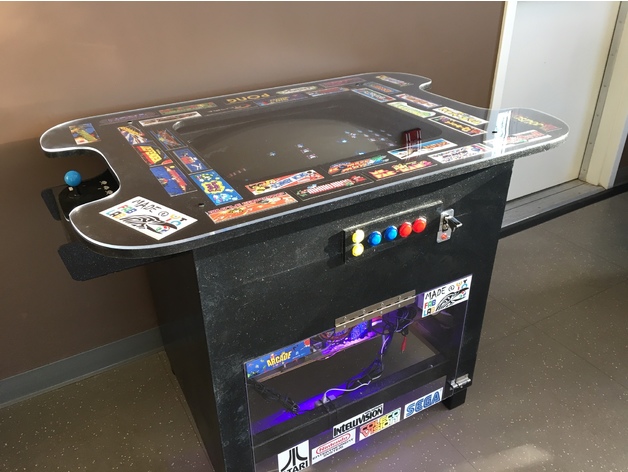

Cocktail Arcade
thingiverse
This project is a full-size cocktail arcade cabinet built from scratch with no prior designs or plans in place. The materials used include an older Phillip's CRT 28" TV, Raspberry Pi 3, COWEEN HDMI to AV Adapter, Easyget LED Arcade Buttons/Joystick, and various wood components like 2x4's and MDF board. Printer Settings Printer: ShopBot Rafts: Doesn't Matter Supports: Doesn't Matter How I Designed This Step 1 The first step was removing the CRT monitor from its housing with great care. The CRT was carefully discharged, and circuit boards were removed. Structural designs for the cabinet were made on the fly using available wood materials in the shop. A basic frame for the monitor was built with 2x4's and wood screws to support the heavy screen. Step 2 I installed a section of plywood inside the housing that held the TV's electronics, Raspberry Pi, and speakers. These components were secured with hot glue, including a power strip and LED light that were later installed. The sides were made from MDF board and routed to fit perfectly. Everything was spray painted black with metallic flakes, then covered in an epoxy for gloss and durability. A side panel was constructed from 1/4" clear acrylic to prevent accidental exposure to internal wiring while still maintaining a view of the inside. The panel was installed with hinges and locks, cut precisely with our laser cutter to fit perfectly. Step 3 After completing the housing, I turned my attention to building joystick housings without any original plans in place. I found images online that served as guides for each housing. The wood used was 1/4" plywood, cut on an Epperson laser cutter. Small 1"x1" blocks were added to each corner for increased durability. Everything was spray painted separately and mounted to the table. A bar top was used for the top and front to decrease scratches and enhance gloss. Step 4 The top of the cabinet was made from 3/4" OSB, based on images found online that I edited in Photoshop to size. It was cut on our Shop Bot. The design dimensions were 32" W by 40" L. The inside hole was slightly smaller than the television screen, covering up the edges. Due to time and cost constraints, I sanded and painted instead of using a router and line both edges with t-molding. The top layer was 1/2" clear acrylic, which has held up fine despite my initial concerns about scratch resistance. I had considered having a glazer cut 1/2" glass but decided against it due to cost. Step 5 My next step involved soldering wire extensions from the TV circuit board and running these connections to buttons on the side. Volume, Channels, Power, and Options were connected, along with a final kill switch that controls power. The interior electronics were cleaned up and organized accordingly. The final step was creating images for the top using our large printer to create retro game images and console logos.

With this file you will be able to print Cocktail Arcade with your 3D printer. Click on the button and save the file on your computer to work, edit or customize your design. You can also find more 3D designs for printers on Cocktail Arcade.
